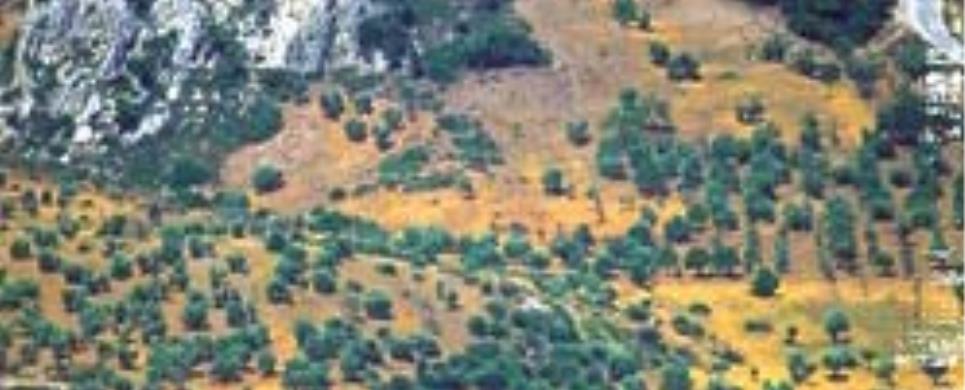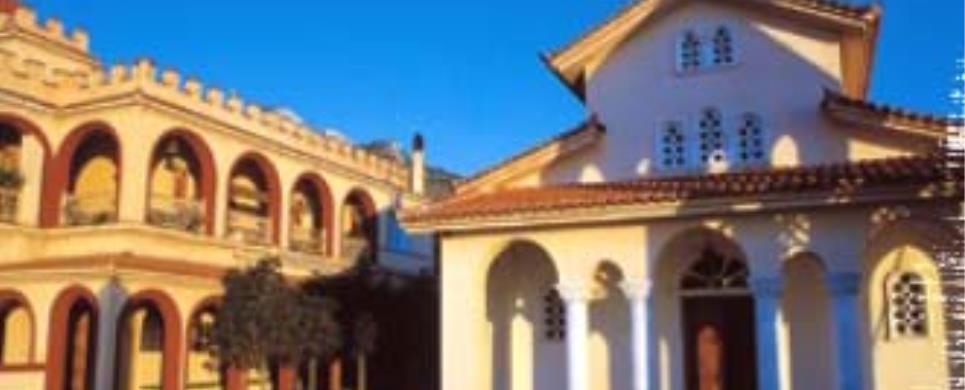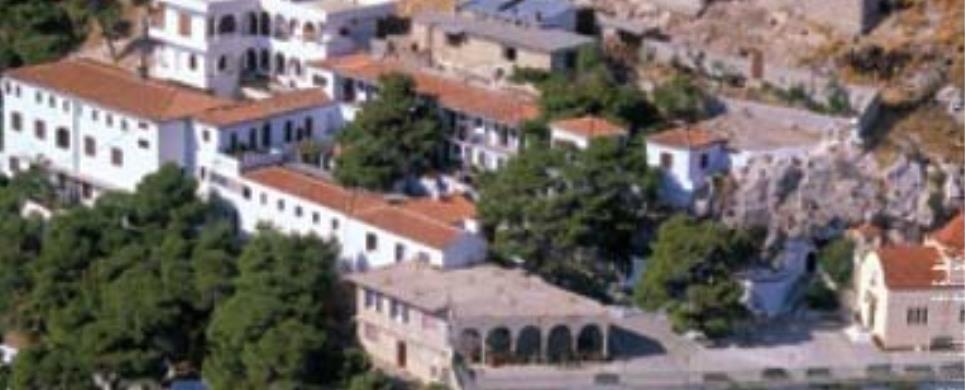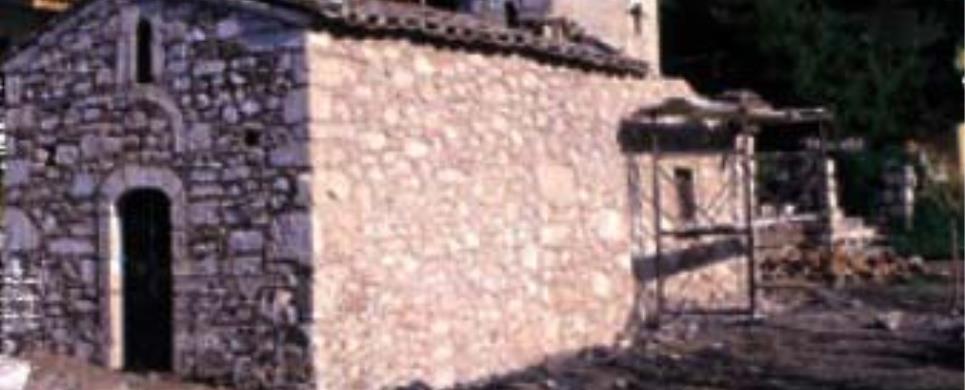Listed 63 sub titles with search on: Places of worship for wider area of: "CORINTHIA Prefecture PELOPONNISOS" .
ANO TRIKALA (Village) TRIKALA KORINTHIAS
In Kato Trikala, the church of St Dimitrios, built in 1697, with its
impressive impressionistic murals of the 18th century, is of special interest.
The text (extract) is cited January 2004 from the Municipality
of Xylokastro pamphlet.
In Ano Trikala is the church of St Nicolas, dating from the 19th century;
it is the metropolis of the village, with beautiful murals and portable icons.
The text (extract) is cited January 2004 from the Municipality
of Xylokastro pamphlet.
ASPROKAMBOS (Settlement) LOUTRAKI-PERACHORA
This church dedicated to Our lady as “the fount of life”,
is a single-aisled building with a pitched roof and can be found at Asprokampos
near Perachora. Its walls
are built with ancient materials, consisting of isodomic masonry.


HERAION (Ancient sanctuary) LOUTRAKI-PERACHORA
There are three churches in the vicinity of the Heraion: those of
St Nicholas, of St John in the archaeological site, and of the Transfiguration
of Our Lord near Vouliagmeni lake.
The church of St Nicholas was built some 200 years ago on a natural acropolis
to the east of the harbor which once sewed the Heraion. It is a single-aisled
basilica with a vaulted roof whose middle sanctuary apse is within a huge rock.
There is a feature of interest on the west side of the exterior: a window that
also serves as a gun-slit and bears an elaborate ornament that originated in some
Early Christian church.

LOUTRAKI (Town) CORINTHIA
In the center of the city of Loutraki is the impressive and peaceful
Cathedral dedicated to Saint John the Baptist. An earthquake destroyed the first
building, which was founded on February 1st 1886. The present Church was built
in the same place in 1933 and founded by His Reverence Metropolite Damaskinos
on April 10, 1933.
The style of the church based on a study of Orlando, is a three-aisle
basilica with its middle aisle raised in order to obtain plenty and natural sunlight.
The yard is beautifully taken care of and artistically planted. In the N.W. of
the church stands the Campanile with a built-in staircase. The hagiography is
exceptional and according to Byzantine style. This can be seen in the masterpiece
of The Most Holy Virgin Mother in the middle niche of the sanctuary, dated prior
to 1930s. In the church there are some portable holy icons and delicated wood-carved
holy icon-stands of Saint John the Baptist and Osios Patapios.
The commemoration of Saint John The Baptist is devoutly celebrated
on August 29 of each year.

Our Lady “tou Prathi” is one of the most important Byzantine
monuments in the Loutraki area. It lies 20 km. from Loutraki, at an altitude of
1,150 metres on an idyllic plateau in the Geraneia
mountains, surrounded by pine-trees and firs. Once there was a wealthy coenobitic
monastery on the same site; its history is recorded from the Byzantine period
to 1821. Of that original foundation, traces of some cells and storerooms have
survived, along with the catholicon, which dates from the eleventh century. It
was dedicated to Our Lady “Phaneromene”, but it is popularly known
as Our Lady “tou Prathi”. The church is most notable for its excellent
wall paintings, in the Byzantine style and on Biblical themes. On the right-hand
door of the sanctuary is a plaque recording that the wall paintings were executed
in 1466.
Another church, dedicated to the Dormition of Our Lady, was built
at a later date a few meters to the north of the old catholicon. This is a notably
well-constructed three-aisled basilica with a dome. The enchanting natural setting
of the two churches and their wealth of history make a visit to the site unforgettable.

In the center of Loutraki stands the imposing church of Our Lady,
an unshakeable pillar of the faith of the Ιοcal people. Inside is kept a miraculous
icon of Our Lady, with an interesting history and origins.
The icon once belonged to a lady called Maria who was visiting continuously
Loutraki on her holidays in the 1920s. She stayed in the house of an old lady
called Maria Sokou - the two women had become friends- to whom she gave an icon
of Our Lady, which she had brought to Greece
from Jerusalem. The icon,
measuring 57 cm. by 49 cm., shows Our Lady as a young woman, holding the divine
infant. The donor of the icon died as she had predicted - three weeks later,
but Maria Sokou kept the precious gift, which had the property of instilling hope
and consolation in all those who sought the succor of Our Lady: Countless miracles
were attributed to the icon, and its renown soon spread beyond Loutraki. In 1928,
the foundations were laid to the first church dedicated to Our Lady in which the
icon was housed, but it soon proved too small for the hosts of pilgrims and thus
a new and larger church was built in 1960.
The new church, which we see today, is a three-aisled basilica with
an octagonal dome. There are the wooden screen and the carved wooden iconostasis
from the church of 1928, and the paintings are the work of Κ. Yeorgakopoulos and
D. Soukaras (1966). The church of Our Lady “Yatrissa” holds its feast
on 8 September; on the previous day, the icon was carried in procession round
the town, with the participation of ecclesiastical, civil and military authorities
from all over Greece.

In the east of the city of Loutraki, on the foot of the Gerania
mountain, is the imposingly serene and of double hypostases holy church of Agios
Fanourios and Apostle Kosmas Etolos.
The commemoration of the Saints is devoutly celebrated on August 24
& August 27 respectively every year.
The church was built in 1968 on the foundations of another smaller
church and was consecrated by His Reverence Metropolite Panteleimona on July 31,
1969. It is built with a double casted tiled roof and an eight-sided dome with
a single foiled window on each side.
The courtyard, in the west, is nicely planted and in the north stands
the imperial Campanile adjoined to the main temple with an arched pilar shed.
The inside walls are beautifully detailed with Saints and Byzantine
Signs. Of special interest is the hagiography in the inner dome, of Pantocrator.
A fine oratory dedicated to Agios Prokopios has been recently added,
in the north of the church.

The church of St Andrew, in Loutraki itself, is the most prominent
feature in the old spa town. It was built in 1345 by the Byzantine Emperor John
VI Kantakouzenos in commemoration of the persecution of St Andrew. The bearing
structure of the church was seriously damaged by the earthquake of 1981, and has
had to be supported. However, the repair work is scheduled to be completed soon,
and the church will be restored to its original form.
St Andrew has all the features typical of Byzantine churches. It is
a three-aisled basilica with a dome resting on a cylindrical drum, a tripartite
sanctuary and an interesting stone-built screen. According to the local people,
its walls were once covered with paintings, but these have disappeared. On the
north side of the precinct, some steps lead down to a cave in which St Andrew
took refuge from the Roman soldiers who were pursuing him. According to tradition,
after he had entered the cave a thick spider’s web covered its entrance
so that the saint’s pursuers could not see where he had gone.

The picturesque chapel of St George stands a short way outside Loutraki,
on the road leading to Perachora.
It was built in 1938 and has an elegant porch and a tiled pitched roof. There
is an excellent view of the Gulf
of Corinth from the vicinity of the chapel.

As we follow the beautiful route to Preacher and enjoy the fine view
out across the Gulf of Corinth,
we come to the attractive church of St Paraskevi, 6 km. from Loutraki. The first
church on the site was built in 1952; this standing there today, was built after
the earthquake of 1981, and is a single-aisled structure with a vaulted roof.

PERACHORA (Settlement) LOUTRAKI-PERACHORA
In the center of Perachora village, the Holy Church of the Assumption
can be found. The architecture style of the church-built in 1982- is a three-aisle
basilica with a tiled roof dome. South west of the church stands the imposing
Campanile surrounded by a beautifully handled with care yard. The inner walls
are nicely covered with Hagiographies and Byzantine Signs, facts that establish
the religiousness of the faithful.

Eight kilometers along the road from Loutraki
to Perachora, by the hill, which was once the acropolis of ancient Peraea,
stands the little single-aisled basilica of St Demetrius, which was built and
had its wall paintings executed in 1750. These paintings - depicting Our Lady
enthroned, the Crucifixion, Christ Pantocrator, the saints in attitudes of prayer,
etc. - are works of great art, and a visit to the church cannot fail to be spiritually
uplifting.

This historic church is in Perachora itself and dates from 1767, when
Greece was still under Turkish
rule. The twelve steps leading to its entrance and the little doors of the church
were constructed in such a way to prevent the conquerors from riding their horses
inside during the service and desecrating the holy place, as was their custom.
In 1832 after the liberation of Greece
- a political faction called the “Constitutionalists” made the church
their headquarters when they were forced to leave Argos
after a dispute with the supporters of Count Capodistrias, first Governor of Greece.

Fifteen kilometers along the road to Vouliagmeni
from Perachora is the pretty chapel of St Blaise, built in 1981. The surrounding
landscape is very attractive, and ancient potsherds are common. There is another
little church of St Blaise in Perachora, at the spot called Aremada.

After an ancient fountain 9 km. along the road from Vouliagmeni
to Asprokampos, is the church
of the Prophet Elijah, standing on a low hill. The foundations consist of ancient
building materials, of which there is no shortage in the area.

On the road to Strava,
after about 6 km., we come to a little roadside shrine. An uphill path from there
leads to a little chapel dedicated to the Seven Maccabees, a quaint structure
three-quartets of which is built into a cave. In its courtyard is a tall oak tree,
which is said to be as old as the church itself. This idyllic spot is believed
once to have been the hermitage of a monk called Maccabaeus.

Four kilometres beyond the Bethlehem Orphanage on the road from Loutraki
to Perachora is the pretty church of Our Lady “Ipapanti”. The church
is built in undressed stone and has a pitched wooden roof covered with tiles.

The little chapel of St George is located in a cave at the spot called
Trepes near Perachora. The cave is also full of stalactites, from which water
drips. It is believed locally that the water has medicinal properties, which are
attributed to the miraculous influence of St George.

PISSIA (Village) LOUTRAKI-PERACHORA
The picturesque chapel of St Athanasius is close to the village of
Pisia (1.5 km. from Loutraki)
and is reached along a forestry road to Platanos. It was built in the fifteenth
century and has wall paintings of 1638, the work of the priest-monk Seraphim Koulouris
from Thebes. Among the subjects
are Christ Pantocrator, the Resurrection and Ascension of Christ, St Mandelius,
Sts Peter and Paul, and the Day of Judgment.

The chapel of St, George is located in a natural cave near Schinos,
9 km. from Pisia. In Byzantine times, it seems very likely that the cave was used
as a hermitage. Today, traces of a painting of St George on horseback have survived
on the screen, and seem to date from around 1400.

This is the “cathedral church” of Pisia: a three-aisled
cruciform basilica with a dome. It stands on the site of an ilate eighteenth-century
church, which was flattened by the earthquake of 1981.

SCHINOS (Settlement) LOUTRAKI-PERACHORA
Two kilometers to the east of Schinos on the road to Alepochori
is the single-aisled church of St Blaise. The original structure dates from 1969,
and much care was put into its later reconstruction.

As we head down towards the sea at Schinos, we
come to the church of the Transfiguration, which over the course of the centuries
has undergone frequent alterations and additions. In earlier times, it was a groin-vaulted
building, but today it is a single-aisled structure with a vaulted roof. The ornamentation
of the window in the semicircular sanctuary apse takes the form of a dog-toothed
band of ceramics, which means that the earliest building phase can be dated back
to the twelfth or thirteenth century. To the east are the foundations of a semicircular
apse, which presumably belonged to an earlier and much larger church.

ANO TRIKALA (Village) TRIKALA KORINTHIAS
Tel: +30 27430 91210, 71222
Leaving Ano Trikala behind, after 800m the road leads to the historical
monastery of St Vlassios, built around 1400, with its yard full of flowers and
trees and a truly magic view for the visitor.
The text (extract) is cited January 2004 from the Municipality
of Xylokastro pamphlet.
Tel: +30 27430 24489
In Mesaia Trikala of Trikala, we come across the Monastery of the
Assumption, dating back to the 19th century, with a stone-built catholic.
Today it is abandoned.
The text (extract) is cited January 2004 from the Municipality
of Xylokastro pamphlet.
IERA MONI AGIOU GEORGIOU FENEOU (Monastery) FENEOS
Tel: +30 27470 41226
An important monastery complex northwest of the village of Kalyvia.
The catholikon is a domed basilica with narthex and exonarthex, built in 1693.
In 1754 the church was renovated and wall paintings were made by Panayiotes of
Ioannina. The carved templon dates to the 18th century.
ISTHMIA (Village) LOUTRAKI-PERACHORA
Tel: +30 27410 49300
KAMARI (Village) XYLOKASTRO
Tel: +30 27430 22043
Tel: +30 27420 51489
LOUTRAKI (Town) CORINTHIA
Tel: +30 27440 23035
In Loutraki, near the Health center, the Holy Cloister of Christ’s
Resurrection dominates the surroundings. The cloister, which used to be a convent
from 1930 until 1990, was erected in honor of a blessed icon of the Christ’s
Resurrection with the engraving “1834 December 20”. It belonged to
the founder and first confessor at the cloister, a Cretan gentleman, Mr. Kyros
Ignadios Pedarakis.
The sanctuary dedicated to the Christ’s Holy Resurrection, can
be found in the interior, which is surrounded by protective stonework. Its architecture
style is basilica with a double casted timbered roof. In the interior of the sanctuary
are the unique ornamental wood-engraved temple and of Athos style chandelier.
A number of exceptional icons dating back to the early century detailed
in Mount Athos, are well
preserved. Amongst them is the icon of Our Most Holy Lady Gorgoepikoou. Apart
from the sanctuary in the cloister two more oratories can be found. One dedicated
to our Lady Protector and the other dedicated to Saint Elefterios where sacred
relics of the Saint are devoutly kept.
On Easter day there is a glorious celebration, on Easter Monday a
feast full mass in honor of Christ’s Resurrection.
Since 1990 a brotherhood has been established that lives in obedience
to Christ’s Rules, following the Holy Canons of monastic life, as they have
been settled by the Fathers of the Church in compliance with Christ’s commands:
“love Lord .... this is the prime command. Second to this, love thy neighbor
as yourself”.
In the center of the city of Loutraki
is the Cathedral dedicated to Saint John the Baptist. The first building, which
was founded on February 1st 1886, was destroyed by an earthquake. The present
Church was built in the same place in 1933 and founded by His Reverence Metropolite
Damaskinos on April 10, 1933. The style of the church based on a study by Orlando,
is a three-aisle basilica with its middle aisle raised in order to obtain plenty
and natural sunlight. The hagiography is exceptional and according to Byzantine
style. This can be seen in the masterpiece of the Most Holy Virgin Mother in the
middle niche of the sanctuary is dated prior to 1930s. In the church there are
some portable holy icons and delicated wood-carved holy icon-stands of Saint John
the Baptist and Osios Patapios.
This text (extract) is cited November 2003 from the Municipality
of Loutraki - Perachora tourist pamphlet.
What is called the “German road” leads east of Loutraki
and after 10 km. of fine scenery brings us to the nunnery of the Holy Trinity,
set amid the serenity of the verdant forest. The nunnery was founded in 1962 on
a site which since 1933 had been occupied by a chapel built by the nun Christodoule.
It is a dependency of Esphigmenou Monastery on Mt
Athos, and follows the Old Calendar: Today there are seven nuns.
Nearby are the chapels of Our lady “Zoodochos Piyi” (1969),
of Sts Cosmas and Damien, and of Our lady “Aghia Skepe”. Also in the
vicinity is the spot known as Golgotha, where there are schematic depictions of
the divine drama.

Tel: +30 27440 54519, 58223
On the way to the Hosios
Patapios Monastery, just after the seaside park in Loutraki and 80 meters
to the right of the Hydrotherapy Centre, we come to the monastery of St Marina.
It was built in 1981 and the wall paintings in the catholicon (main church) are
the work of the monk Makarios Voyatzoglou.

Tel: +30 27440 79451
We continue along the same road and, passing the turning for Hosios
Patapios, we come to the monastery of St Gerasimos. Around the precinct are
the guest-rooms of the monastery, the guesthouse proper, the waiting rooms and
a little chapel of Our Lady “Eleftherotria”. Outside the west wing
stands a stone cross 13 meters in height; which is lit at night. According to
the tradition, it was on this very spot that a pious clergyman met St Gerasimos
himself; the saint was holding a large cross and throwing firecrackers.
Close to the monastery is the little chapel of St Panteleimon, built
in 1981 on the foundations of an earlier church.

Tel: +30 27440 23800
Just above the turning for Hosios
Patapios is the monastery of the Prophet Elijah, occupying a commanding position
above Loutraki and offering a superb view of the Gulf
of Corinth. Το the left of the threshold of the monastery is a little chapel,
while above the main entrance is a painting of Our Lady “Wider than the
Heavens”. The southeast side is occupied by the catholicon, built in 1963.
Among other interesting buildings are the chapel of St John of Sinai
and the impressive cave of the Prophet Elijah, in greenish undressed stone.
Tel: +30 27410 98040
MONI KOIMISSEOS THEOTOKOU FANEROMENIS (Monastery) TENEA
Tel: +30 27410 98294

MONI OSSIOU PATAPIOU (Monastery) LOUTRAKI-PERACHORA
Tel: +30 27440 22496
At a distance of 14 km from Loutraki,
along the road to Perachora,
on an imposing site and at an altitude of some 700 m., on a spur of the Geraneia
mountains and above the calm waters of the Gulf
of Corinth, stands the nunnery of Hosios Patapios. The interior of the nunnery
is reached by a spiral flight of 144 steps; amid the pine-trees on the right,
stands the chapel of the Hosia Mary of Egypt.
MONI VRACHOU (Monastery) NEMEA
Tel: +30 27460 22698

PERACHORA (Settlement) LOUTRAKI-PERACHORA
St Nicholas “the Younger”, at the spot called Malagari
near Perachora, seems likely to be the oldest Byzantine monument in the area,
since it was built in the tenth or eleventh century. Experts have quite rightly
described its outstanding wall paintings as historic treasures of the greatest
value. In earlier times, the monastery had a full complement of monks, and even
today the beauty of the scenery does much to uplift the spirits of pilgrims.

Tel: +30 27440 24872
The foundations of the monastery of St Ρaul were laid in 1972 on a
site higher up the mountain, an hour’s walk from the nunnery of Hosios
Patapios. The first monk who established in this isolated place came here
from Mount Athos. Set as
it is amid the dense greenery, the monastery of St Ρaυl is truly a place apart
from the world.
SYKEA (Village) XYLOKASTRO
Tel: +30 27430 24489

ZOODOCHOS PIGI (Small island) ALKYONIDES
On Zoodochos Piyi, there are many more remnants of ancient buildings,
and there is also a monastery of Our Lady, which was founded in the twelfth century
and is still occupied.
According to the tradition, the catholicon of the monastery was built
on the foundations of an ancient temple to Castor and Ροlluχ. The church is dedicated
to the Dormition of Our Lady and is of the cruciform domed architectural type.
In its interior are notable ecclesiastical vessels and icons. A famous triptych
icon called “Our Lady of Kalanisa”, depicting the Virgin and Child
is kept now in the church of the Great Archangels in Perachora.
Receive our daily Newsletter with all the latest updates on the Greek Travel industry.
Subscribe now!